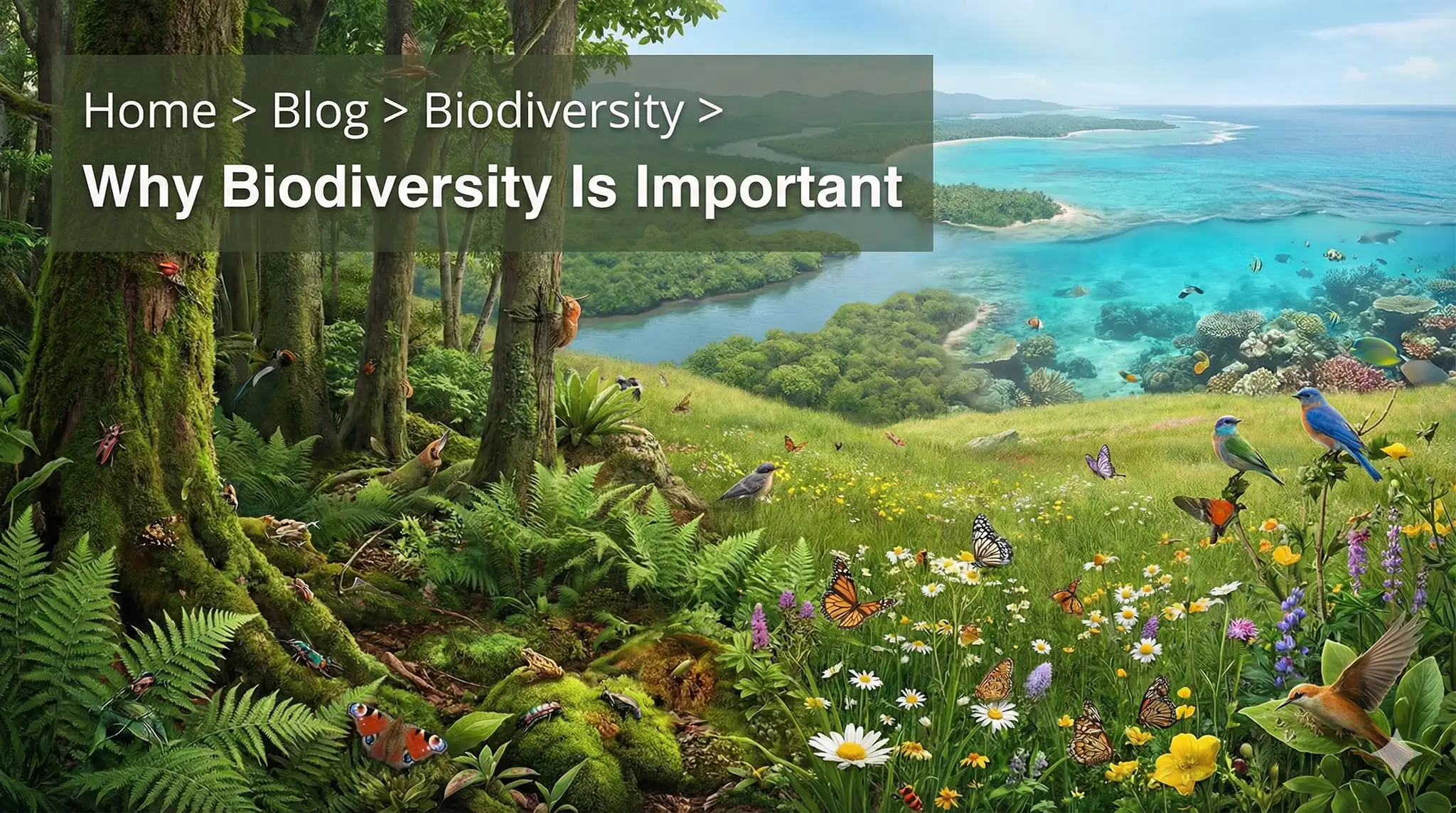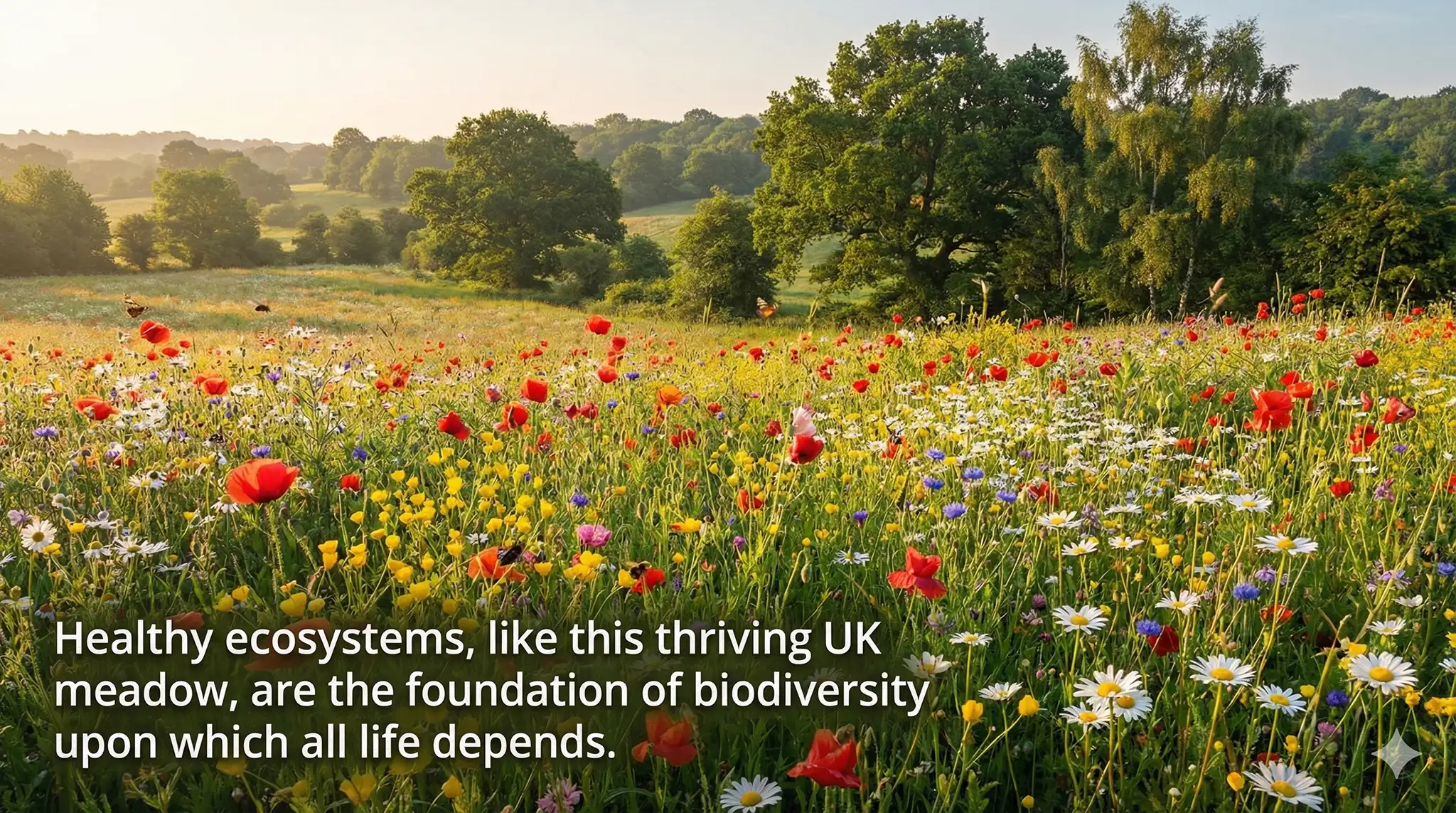Biodiversity Net Gain: What is it and How to Calculate It?
What is Biodiversity Net Gain?
Biodiversity Net Gain is defined as development that leaves biodiversity in a better state than before. It is an approach where developers work with local governments, wildlife groups, landowners, and other stakeholders to support their priorities for nature conservation. This can be achieved on-site by creating new habitats, enhancing existing habitats, or managing existing habitats in a better way for wildlife. For example, mowing regimes can be adjusted to allow some parts of a site to grow longer while others are mown on a rotational basis. It is important to note that net gain also considers off-site improvements, not just those within the development site.
Policy and Legal Position

The National Planning Policy Framework (NPPF) states that planning policies and decisions should contribute to and enhance the natural environment by minimizing impacts on and providing net gains for biodiversity. Previously, the NPPF used the term "no net loss," but in 2018, the wording was changed to "net gain." While it is not yet compulsory, many local planning authorities have started to adopt net gain in their local plans and policies. In the Spring Statement last year, it was announced that biodiversity net gain would be mandated for all development.
Calculating Biodiversity Net Gain
To calculate biodiversity net gain, developers must first assess the existing biodiversity value of a site. This can be done using various tools and methodologies, such as the Defra Biodiversity Metric or the Natural England Habitat Evaluation Procedure. Once the baseline biodiversity value is established, developers can then identify opportunities for on-site and off-site habitat creation, enhancement, and management to achieve a net gain in biodiversity.
Developers should work closely with local stakeholders, such as planning authorities, wildlife groups, and landowners, to ensure that their proposed net gain measures align with local conservation priorities and deliver meaningful benefits for biodiversity. In some cases, it may be necessary to provide financial contributions to support off-site habitat creation or enhancement projects if on-site measures are not sufficient to achieve the required net gain.
In conclusion, biodiversity net gain is an important concept that aims to ensure development leaves the natural environment in a better state than before. By working collaboratively with local stakeholders and adopting appropriate on-site and off-site measures, developers can contribute to the enhancement of biodiversity and support the long-term health of ecosystems.
Schedule 15 within the Environment Bill modifies the Town and Country Planning Act, stating that every planning permission granted for the development of land in England shall be deemed to have been granted subject to the condition that the development may not be begun unless the developer has submitted a biodiversity gain plan to the planning authority and the planning authority has approved this plan. However, this is not yet a compulsory requirement, as the Environment Bill has not been passed through Parliament.
Some local planning authorities have already started adopting the net gain approach, with Warwickshire and Nottinghamshire leading the way, particularly Warwickshire. Additionally, some local authorities have bespoke policies in place that are not entirely compliant with the government plans, but rather have their own policies.
For example, Essex has supplementary plan guidance related to biodiversity restoration and net gain requirements for mineral development. Dorset County Council applies a biodiversity net gain requirement for all authorities within the county for any development over 0.1 hectares. In Lichfield, their guidance stipulates that a 20% net gain is required for development proposals that have an impact on key ecological features.
Moreover, some developers have also adopted this approach, such as Barratt Homes, which has an internal policy in place for all their developments to meet net gain requirements. Large infrastructure and utilities companies like Balfour Beatty and Highways England have also implemented similar policies.
To better understand the adoption of these policies, the GIS team at WYG has started compiling all local policies and plans across England, mapping them to see which local boroughs have adopted the net gain approach. This will help provide a clearer picture of the current state of biodiversity gain planning and its potential future impact on development in England.
Biodiversity Net Gain: Current Status and Future Implementation
Local Authorities and Biodiversity Net Gain
Currently, there is a working document that tracks local authorities' progress in implementing biodiversity net gain. The darkest green colour on the plan represents local authorities following the standard in PPF, while other colours indicate those with emerging plans or existing ones. This tracking system helps advise clients on whether net gain will be a requirement for their projects.
When Will Biodiversity Net Gain Be Mandated?
The exact timeline for mandating biodiversity net gain is uncertain. The Environment Bill was expected to receive Royal Assent by the end of 2020, but due to the global pandemic, it may be delayed. It is important to note that all major political parties included biodiversity net gain in their manifestos during the last election, and there was no significant opposition to the approach. Therefore, it is widely accepted that it will eventually come into effect, but the exact date remains unknown.
Once implemented, the mandate will require all developments to achieve a 10% net gain in biodiversity. However, it is anticipated that there will be a two-year transition period, the details of which are still unclear. It is also expected that the mandate will not be applied retrospectively to sites with existing outline planning consent, and there may be some exclusions for small developments or certain types of permitted development.
How Does Biodiversity Net Gain Work?
The key aspect of biodiversity net gain is that it must be measurable, which means using a metric. This allows for a clear assessment of the impact of a development on biodiversity and ensures that the required net gain is achieved.
Calculating the Value of a Site Pre-Development Using Biodiversity Units
To ascertain the value of a site pre-development, it is essential to measure it in biodiversity units. This process requires an ecology survey, which is more involved and in-depth than a typical phase 1 habitat survey. It is crucial to have this survey conducted by a competent and experienced ecologist.
Calculating Biodiversity Units

To calculate the number of biodiversity units on a site, several steps must be followed:
1. Identify the habitats present within the site.
2. Measure the area and lengths of the habitats. Area-based and linear habitats are assessed separately within the calculator. Linear habitats include streams, rivers, and hedgerows.
3. Assign the habitat distinctiveness. This includes parameters such as species richness (how many of one species are within a habitat), species diversity (how many species are present), the rarity of species, the rarity of the habitat, and the degree to which the habitat supports species rarely found in other habitats.
Habitat distinctiveness is predefined within the calculator. For example, a habitat with high distinctiveness, such as a woodland habitat of principal importance, would automatically score eight. In contrast, a habitat with low distinctiveness, which is not protected by any policy and has little biodiversity value, would score two.
Assessing Habitat Condition
The condition of the habitat is another crucial factor to consider. A thorough survey is necessary to assess the condition accurately. The condition of each habitat is evaluated based on criteria broadly divided into three categories.
In conclusion, calculating the value of a site pre-development using biodiversity units is a complex process that requires an in-depth ecology survey and a thorough understanding of the habitats present. By following the steps outlined above and working with an experienced ecologist, it is possible to accurately determine the biodiversity value of a site before development begins.
Assessing Habitat Conditions and Ecological Connectivity
Habitat conditions can be categorized into three levels: good, moderate, and poor. These levels are assigned points, with good condition receiving three points, moderate receiving two points, and poor receiving one point. To determine the condition of habitat, there is extensive documentation and guidance that must be followed.
For a habitat to be considered in good condition, all but two of the criteria must be met. To score as moderate, several criteria must have failed, and for a habitat to be considered poor, most criteria must have failed. It is important to note that some habitats, such as arable land, will be pre-assigned a poor condition by default.
Ecological Connectivity and Strategic Significance
After assessing the habitat conditions, the next step is to evaluate ecological connectivity and strategic significance. Ecological connectivity can be determined by examining factors such as green infrastructure plans and ecological network maps. The example provided is the Hampshire Ecological Network Map, which can be instrumental in determining a site's strategic significance and ecological connectivity score.
Many local authorities have already produced or are in the process of producing these plans. To ensure accurate assessment, it is crucial to engage with local authorities and stakeholders to discuss the site, the project, and the wider conservation actions happening in the local borough.
Calculating Biodiversity Units
Once all the existing data on a site has been collected, the number of biodiversity units can be calculated. This is done by multiplying the distinctiveness, habitat condition, area, connectivity, and strategic significance. The result is the baseline biodiversity units for the site.
Post-Development Biodiversity Units
After establishing the baseline biodiversity units, the next step is to calculate the post-development biodiversity units. This will require further assessment and analysis of the site and its surrounding environment. By comparing the baseline and post-development biodiversity units, it is possible to determine the impact of a project on the local ecosystem and make informed decisions about conservation efforts.
Understanding Habitat Retention and Future Management
To assess the impact of development on habitats, it is essential to know how much habitat is being retained, how much will be lost, and what new habitat will be created. This information is crucial for determining the future management of the retained habitat.
Calculating Risk Factors
The next step in the assessment process involves calculating risk factors. These factors include the time it will take for a new habitat to reach its target condition and the difficulty of restoring or creating the habitat. Some habitats are easier to create than others, and the environmental conditions of the site will also play a role in determining the difficulty of the restoration or creation process.
It is important to note that habitat compensation is not a simple like-for-like replacement. If a certain amount of habitat is lost, a larger area may need to be created to compensate for the loss of biodiversity units.
Inputting Data and Calculating Biodiversity Units
Once all the necessary information has been gathered, it can be inputted into a calculator that will determine the post-development biodiversity units. This calculation takes into account factors such as distinctiveness, condition, area, connectivity, and strategic significance. Additionally, the two risk factors - time to target condition and difficulty in creation or restoration - are also considered.
Determining Net Gain or Loss
After calculating the baseline and post-development biodiversity units, the final step is to determine whether there is a net gain or loss. If the result is a positive value, this indicates a net gain. However, if the result is negative, it signifies a net loss. It is important to remember that a 10% net gain is required, so even if the result is positive, the percentage must be calculated to ensure it meets this requirement.
A High-Level Example of a Net Gain Assessment
To illustrate the process of a net gain assessment, consider a hypothetical land development project adjacent to a Southampton office. By following the steps outlined above, the impact of the development on the habitat can be assessed, and appropriate measures can be taken to ensure a net gain in biodiversity.
Small Parcel of Land and Biodiversity Net Gain Challenges
In this discussion, we will examine a small parcel of land, less than a hectare (0.78 hectares) in size, and the challenges it presents in achieving biodiversity net gain. The site consists mainly of semi-improved neutral grassland, with a few parcels of broadleaf woodland. When we calculated the existing biodiversity units, we found that the site has a baseline of 6.6 units, with the woodland contributing 0.97 units and the grassland contributing 5.63 units.
Post-Development Biodiversity Units
When we considered the post-development scenario, with the brown area representing the development footprint (essentially a building), we found that the total biodiversity units left would be 3.48, resulting in a 47% loss. To achieve a net gain, we had to reevaluate the site and make some changes.
Achieving Net Gain on Small Sites
To achieve a net gain, we reduced the development building footprint and implemented better management practices for the woodland and semi-improved grassland. As a result, we were able to achieve a 5% net gain. It is important to note that achieving net gain on small sites can be more challenging than on larger, master-planned developments. In cases like this, it may be necessary to consider adjacent habitats and potentially adjust the site's boundaries or explore off-site compensation options.
Off-Site Compensation and Biodiversity Offsetting
When a development site cannot achieve a net gain and experiences a net loss, it may be necessary to provide compensation within the local area or at an off-site location. This is often referred to as biodiversity offsetting. It is crucial to understand that biodiversity offsetting is not separate from net gain; rather, it is a part of the overall process.
In conclusion, achieving biodiversity net gain on small sites can be challenging, but it is possible with careful planning and consideration of both on-site and off-site options. Biodiversity offsetting plays a crucial role in ensuring that development projects contribute positively to the environment and local ecosystems.
Net Gain Assessment and Offset Providers
Biodiversity net gain assessment is not a separate process. When a developer has a net loss in biodiversity, they need to offset it. There are several opportunities for developers to do this by partnering with offset providers. These providers sell conservation projects that deliver biodiversity units, which developers can purchase to compensate for their losses.
Typically, the developer pays a certain amount per unit. For example, if they need to make up for 20 units of biodiversity loss, they will pay a sum of money to the offset provider, which could be a local planning authority, conservation group, or wildlife trust. This payment is required to achieve a 10% net gain in biodiversity units. Alternatively, if the developer owns another parcel of land, they can enhance and maintain that land to offset the development project they are working on.
It is important to note that offset providers are not available in every borough or county. The availability of these providers depends on the location of the development site. However, it is anticipated that when net gain becomes mandated, more opportunities for offset providers will emerge.
Key Points to Remember
1. Biodiversity net gain does not negate the need to follow the mitigation hierarchy. This means that developers should first aim to avoid and retain the most important habitats. Retaining the most ecologically valuable habitats within a site is the best way to minimize the net gain requirement.
2. Net gain cannot be achieved if an irreplaceable habitat, such as ancient woodland, is removed. No matter what compensation is provided, removing an irreplaceable habitat means that net gain is unattainable.
3. Biodiversity net gain cannot be achieved if a development project adversely impacts a strategically designated site, such as a Site of Special Scientific Interest, Special Protection Area, or Special Area of Conservation.
In conclusion, developers must be aware of the importance of biodiversity net gain and the role of offset providers in achieving this goal. By following the mitigation hierarchy and partnering with offset providers when necessary, developers can ensure that their projects contribute positively to the environment and local ecosystems.
Conservation and Common Habitat Limitations
Even common habitats, such as semi-improved grassland, may require significant compensation to achieve the required net gain. There are several limitations to consider when using habitat calculators.
Limitations of Habitat Calculators
1. Focus on habitats, not species: Habitat calculators only consider habitats and not animal species, which can cause conflicts. For example, arable land may score low in the calculator, but it could support a significant population of farmland birds.
2. Time-consuming assessments: Net gain assessments are not simple tasks and can take as long, if not longer, than standard ecological appraisals. To obtain an accurate assessment, a design freeze and a fixed redline are necessary. Any changes to the development footprint or redline would require the calculator to be rerun, as even small changes in area can significantly impact the output.
3. Early assessments are crucial: It is essential to run the assessment as early as possible to establish a baseline that can inform the layout of the master plan. Early assessments also provide an indication of whether the net gain is achievable on-site or if off-site compensation is necessary.
4. Professional judgment and potential errors: Landscape architects and master planners may use different habitat types than those used in habitat calculators, requiring conversion and potentially introducing errors.
5. Variability in metrics: There are numerous metrics available for calculating habitat value. The most common is the Defra metric, which most local authorities seem to adopt. However, some local authorities may use different metrics, leading to variations in calculations and requirements.
In conclusion, while habitat calculators can be useful tools in conservation planning, they have limitations that must be considered. By understanding these limitations, planners and conservationists can make more informed decisions and better protect both habitats and the species that rely on them.
Biodiversity Net Gain: Metrics, Calculators, and Opportunities for Developers
Metrics and Calculators
Biodiversity net gain calculators actually have their own metrics. What you'll find is that different calculators, even if you insert the same data into all of them, will output different results. Therefore, it's essential to use one calculator to ensure a fair and consistent approach for everyone. Additionally, an experienced ecologist who is familiar with the process is needed to advise on some of the more complicated parts of the calculator.
Opportunities for Developers
There are several opportunities for developers in biodiversity net gain. One of the main opportunities is for land that cannot be developed. This land could be used for biodiversity net gain, and then the developers could sell biodiversity credits to other developers who need them. This could work on developer sites with contaminated land issues, for example. The government has indicated that they want to stimulate the economy with biodiversity credits.
Another advantage is that its good practice in marketing new developments. There is a real push on providing open space for new residents and having open green areas, which could be a useful marketing tool. Additionally, standardization across the country is beneficial. If there is one system, one policy, and one protocol in place, it makes the process fairer for developers because everyone is in the same boat.
Biodiversity Net Gain in Multi-Functional Landscapes
Biodiversity net gain can fit into a multi-functional landscape, particularly in large master plan sites. One example of this is sustainable urban drainage systems (SUDS). SUDS are a way of managing surface runoff and pollution from development sites, and the potential for net gain here is high. This is because SUDS often require large areas of space, and in the metric, wetland habitats return a lot of biodiversity units.
Ecologists and Biodiversity Net Gain
Ecologists play a crucial role in assessing the ecological value of different habitats. They need to understand the ecosystem well to input accurate data within the biodiversity calculator. For example, a habitat that is dry for half the year won't score as highly as one with water contained within it all year round.
Public Open Space and Biodiversity Net Gain
In many local plans, the provision of public open space is a requirement. This can tie in well with biodiversity net gain, as the public open space can serve a dual function. Examples of this include community orchards and replacing amenity grass road verges with species-rich grassland. However, conflicts may arise due to recreational impact from dogs, habitat degradation, and public safety concerns. While these areas can contribute to biodiversity net gain, they may not achieve high target conditions.
Species Mitigation and Biodiversity Net Gain
For sites with protected species, such as great crested newts and dormice, legislation and licenses require the development to maintain favorable conservation status for those species. This means that habitats will be retained and enhanced for these species, which ties in well with a net gain approach. Retaining habitat for protected species will contribute to the biodiversity units on a site, making the 10% net gain target more achievable.
Conclusion
With biodiversity net gain becoming mandatory, many developments will likely require an increased amount of habitat creation. However, this doesn't necessarily mean that achieving the target will be impossible. By considering the ecological value of different habitats, incorporating public open spaces, and focusing on species mitigation, developers can work towards achieving biodiversity net gain while also meeting other requirements and addressing potential conflicts.



